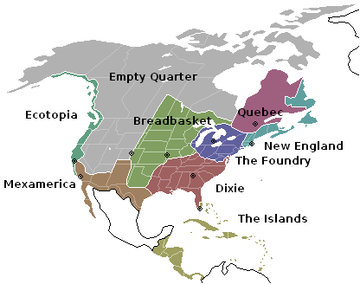The Nine Nations of North America
The Nine Nations of North America is a book written in 1981 by Joel Garreau. In it, Garreau suggests that North America can be divided into nine regions, or "nations", which have distinctive economic and cultural features. He also argues that conventional national and state borders are largely artificial and irrelevant, and that his "nations" provide a more accurate way of understanding the true nature of North American society. Paul Meartz of Mayville State University called it "a classic text on the current regionalization of North America".[1] The Nations reflected here are included in a Michael F. Flynn short story, in which all the Nine Nations have gained independence.
The Nine Nations

- New England — an expanded version including not only Maine, New Hampshire, Vermont, Rhode Island, Massachusetts and Connecticut (although omitting the Connecticut suburbs of New York City), but also the Canadian Atlantic provinces of New Brunswick, Nova Scotia, Prince Edward Island, and Newfoundland and Labrador. Capital: Boston.
- The Foundry — the by-then-declining industrial areas of the northeastern United States and Great Lakes region stretching from New York City to Milwaukee, and including Chicago, Indianapolis, Cleveland, Toledo, Philadelphia, and Southern Ontario centering on Toronto. Capital: Detroit.
- Dixie — the former Confederate States of America (today the southeastern United States) centered on Atlanta, and including most of eastern Texas. Garreau's "Dixie" also includes Kentucky (which had both a Union and a nominal Confederate government); southern and southeastern portions of Missouri, southern Illinois, and southern Indiana; and the "Little Dixie" region of southeastern Oklahoma. Finally, the region also includes most of Florida, as far south as the cities of Fort Myers and Naples. Capital: Atlanta.
- The Breadbasket — most of the Great Plains states and part of the Prairie provinces: Iowa, Kansas, Minnesota, Nebraska, the Dakotas, almost all of Oklahoma, parts of Missouri, western Wisconsin, eastern Colorado, the eastern edge of New Mexico, parts of Illinois and Indiana, and North Texas. Also included are some of Northern Ontario and southern Saskatchewan and Manitoba. Capital: Kansas City.
- The Islands — The South Florida metropolitan area, the Everglades and Florida Keys, and the Caribbean. Capital: Miami.
- Mexamerica — the southern and Central Valley portions of California as well as southern Arizona, the portion of Texas bordering on the Rio Grande, most of New Mexico, northern Mexico, and the Baja California peninsula. Capital: Los Angeles.
- Ecotopia — the Pacific Northwest coast west of the Cascade Range and the Coast Mountains, as well as several Alaskan Pacific Coast Ranges, stretching from Alaska down through coastal British Columbia, Washington state, Oregon, and into California just north of Santa Barbara. Capital: San Francisco.
- The Empty Quarter — most of Alaska, Nevada, Utah, Wyoming, Idaho, Montana and Colorado from Denver west, as well as the eastern portions of Oregon, California, Washington, all of Alberta and Northern Canada (including what is now Nunavut), northern Arizona, parts of New Mexico (mainly the area controlled by the Navajo Nation), and British Columbia east of the Coast Ranges. Capital: Denver.
- Quebec — the primarily French-speaking province of Canada, which held referenda on secession in 1980 and 1995, the latter of which the "separatists" lost narrowly. Capital: Quebec City.
Garreau also discussed several areas that he termed "aberrations":
- Washington, D.C. and its surrounding area, specifically referring to the area "inside the Beltway".
- Manhattan south of Harlem (he placed Harlem, and by extension the Manhattan neighborhoods to its north, clearly within The Foundry), along with Connecticut's Fairfield County.
- Hawaii, which the author considered an Asian aberration as much as a North American aberration.
- Northern Alaska, despite its categorization on the front cover as part of the Empty Quarter, was listed in the aberrations section of the book.
- Although not included in the "Aberrations" chapter of his book, Southern West Virginia was named by Garreau as a region which had significant aspects of both Dixie (Appalachian geography and historical ties to Virginia) and The Foundry (coal-based and unionized economy closely tied to the fortunes of the Rust Belt), and could be placed in either nation. Garreau's conclusion about the region was "In good times, southeastern West Virginia can be considered an isolated part of the Foundry. In bad times, it is an isolated part of Dixie." Garreau placed the northern half of the state in The Foundry.
See also
Notes
References
- The Nine Nations of North America
- Garreau's original map and detailed statistics
- Garreau's analysis summarized
Further reading
- American Nations: A History of the Eleven Rival Regional Cultures of North America (2011) Colin Woodard
